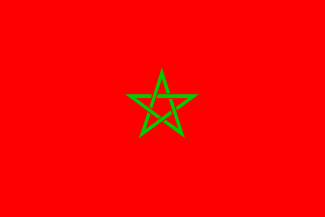Wednesday 4 April 2007
We leave home around 9.30am and
take the tramway towards Rotterdam Central Station. There we catch the 8.59
intercity service to Amsterdam Airport Schiphol. Once there we have to complete
the half way successful online check-in. We will be flying British
Airways via London
Heathrow to Casablanca. I was unable to print the boarding pass for the
second leg of the journey. The seat reservations were in order though. 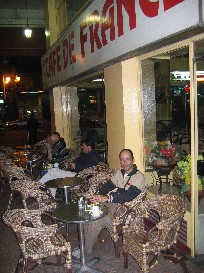 We
have seats on the exit row, which is a good thing considering Erik's height of 2.02m
(6'7.5"). We fly at 11.40 to London. The flight is uneventful and in London
we find ourselves in mile long queue for the security check in Terminal 4. We
were cleared we take the bus (15 mins) to Terminal 1, where we have 2 hours to
"spare". It takes long before we finally get an indication of the gate
for our second flight. As soon as we see our flight on the information screens
we head for the gate only to be stopped in our tracks for yet another
queue and security check. In the end our flight leaves 40 minutes late. We make
up for some of the delay arriving at Aéroport
Mohammed V near Casablanca at 6.20pm (in stead of 6pm). Time here is two
hours behind the Netherlands (Morocco has no day light saving time). We get through
immigration reasonably fast and our baggage is quick to arrive as well. We
withdraw some cash from an ATM in the arrivals hall (Moroccan money is not available
overseas as it not allowed to export it) and we buy a ticket in the underground
train station. The train for Casablanca leave 7.10pm about ten minutes late.
Within half an hour we arrive at Casablanca Voyageurs station. Here we find out
that all taxi drivers have gone on strike today and no one will carry us.
Officially that is, because one of them offers to pick us up across the street
out of sight of his colleagues. We take the offer as we have no choice. We are
driven to our hotel, but pay for it dearly (200 dirham, or $22/€18/£12 in
stead of ± 10dh). We
have seats on the exit row, which is a good thing considering Erik's height of 2.02m
(6'7.5"). We fly at 11.40 to London. The flight is uneventful and in London
we find ourselves in mile long queue for the security check in Terminal 4. We
were cleared we take the bus (15 mins) to Terminal 1, where we have 2 hours to
"spare". It takes long before we finally get an indication of the gate
for our second flight. As soon as we see our flight on the information screens
we head for the gate only to be stopped in our tracks for yet another
queue and security check. In the end our flight leaves 40 minutes late. We make
up for some of the delay arriving at Aéroport
Mohammed V near Casablanca at 6.20pm (in stead of 6pm). Time here is two
hours behind the Netherlands (Morocco has no day light saving time). We get through
immigration reasonably fast and our baggage is quick to arrive as well. We
withdraw some cash from an ATM in the arrivals hall (Moroccan money is not available
overseas as it not allowed to export it) and we buy a ticket in the underground
train station. The train for Casablanca leave 7.10pm about ten minutes late.
Within half an hour we arrive at Casablanca Voyageurs station. Here we find out
that all taxi drivers have gone on strike today and no one will carry us.
Officially that is, because one of them offers to pick us up across the street
out of sight of his colleagues. We take the offer as we have no choice. We are
driven to our hotel, but pay for it dearly (200 dirham, or $22/€18/£12 in
stead of ± 10dh).
We stay at the Best
Western Le Toubkal. Have checked in and moved into our unremarkable room we
go out for drinks at the side walk Café de France. I take min tea (very sweet), Erik
coffee. A constant stream of people parade on the side walk in front of us.
Great to watch it go by. Then it gets too chilly and we move to the Restaurant des
Fleurs. A sort of café cum restaurant. Here I take another tea and Erik a
Moroccan beer. The tea costs only 9 dh (~ $1/€0,82/55p), but the beer no less
than 32dh ($3,45/€2,90/£1.95).
Tired from the journey
and the impressions we go to bed early.
Thursday 5 April 2007
We rise early around 7am.
Breakfast is served quickly, but it is very simple: tea/coffee, bread, jam and
cheese.  The
taxi drivers are still on strike and we cannot take one to the Hassan II moskque,
which we want to visit nor the car rental firm. We decide to walk to the
mosque, which is about 20 minutes away from the hotel. We want to be there by
9am to join a tour of the building. The Hassan II mosque was finished in
1993 after six years of hard work. It was commissioned by the King himself. It
is the third largest mosque in the world (after Mecca and Medina) and has the
highest minaret (200m). It holds 25,000 worshippers and its roof can be opened
electrically. The mosque has more technical innovations. The mosque is
beautifully situated on a artificial promontory on the Atlantic coast. All the
materials come from Morocco except for the chandeliers, made out of Venetian
glass and two marble columns from Carara. The ablutions are underground,
separate for men and women The
taxi drivers are still on strike and we cannot take one to the Hassan II moskque,
which we want to visit nor the car rental firm. We decide to walk to the
mosque, which is about 20 minutes away from the hotel. We want to be there by
9am to join a tour of the building. The Hassan II mosque was finished in
1993 after six years of hard work. It was commissioned by the King himself. It
is the third largest mosque in the world (after Mecca and Medina) and has the
highest minaret (200m). It holds 25,000 worshippers and its roof can be opened
electrically. The mosque has more technical innovations. The mosque is
beautifully situated on a artificial promontory on the Atlantic coast. All the
materials come from Morocco except for the chandeliers, made out of Venetian
glass and two marble columns from Carara. The ablutions are underground,
separate for men and women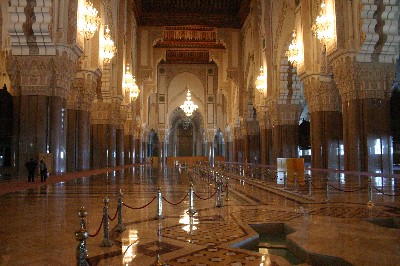 .
There is also a Hammam, beautifully styled and decorated, but has yet to be
completed. After the tour we walk back along the shoreline and past the port.
The hotel reception has called Sixt car
rental. They will come and collect us, because we cannot come to them. It
turns out to be a long ride to the affluent district of Maarif. After sorting
out the formalities and filling up the tank we are directed on our way to
Rabat. We are soon on the motorway bound north to Rabat. Rabat is about 90
km (56mi) north. With 90 minutes we arrive at the Royal
Hotel. The hotel is fine and we get a room on the roof top with a
great balcony and a view on the square. We have lunch nearby at La Mamma, .
There is also a Hammam, beautifully styled and decorated, but has yet to be
completed. After the tour we walk back along the shoreline and past the port.
The hotel reception has called Sixt car
rental. They will come and collect us, because we cannot come to them. It
turns out to be a long ride to the affluent district of Maarif. After sorting
out the formalities and filling up the tank we are directed on our way to
Rabat. We are soon on the motorway bound north to Rabat. Rabat is about 90
km (56mi) north. With 90 minutes we arrive at the Royal
Hotel. The hotel is fine and we get a room on the roof top with a
great balcony and a view on the square. We have lunch nearby at La Mamma,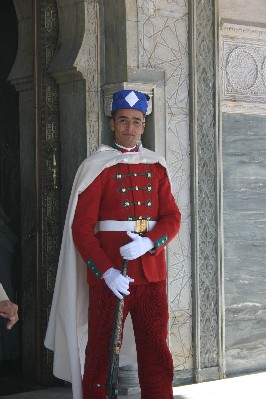 a more or less Italian restaurant. After lunch we have a break, before we set
out for the mausoleum of Mohammed V.The mausoleum is next to the
remains of the 12th century Hassan mosque. This must have been a gigantic
mosque, if the unifinished
a more or less Italian restaurant. After lunch we have a break, before we set
out for the mausoleum of Mohammed V.The mausoleum is next to the
remains of the 12th century Hassan mosque. This must have been a gigantic
mosque, if the unifinished Hassan tower or minaret is anything to go by. Judging by the ruins the
mosque could have held 25,000 worshippers if had been completed and would have
been the second largest in the world at the time. We take a look at
the mausoleum, where the late king is burried. His son Hassan II and his brother
are burried next to him. Mohammed V was the first king of Morocco after
independence in 1956, when Morrocco stopped being a French (and Spanish)
protectorate. The shrine is guarded by handsome and spectacularly uniformed
guards.
Hassan tower or minaret is anything to go by. Judging by the ruins the
mosque could have held 25,000 worshippers if had been completed and would have
been the second largest in the world at the time. We take a look at
the mausoleum, where the late king is burried. His son Hassan II and his brother
are burried next to him. Mohammed V was the first king of Morocco after
independence in 1956, when Morrocco stopped being a French (and Spanish)
protectorate. The shrine is guarded by handsome and spectacularly uniformed
guards.
We walk towards the Medina,
the old town. We stroll through the busy souks, past the market stalls and
shops, selling a wide range of goods and services. There are lots of food
stalls, but also furniture, carpets and shoes. The countless tiny shops selling
the same goods in the same street. It quite a sight seeing the small tailor,
shoemaker and carpenter workshops. This small scale of commercial activity looks
almost medieval. Most Moroccan cities have, beside the old Arab Medina a Ville Nouvelle,
which were built during the French Protectorate (1906-1956) by the French,
according to French standards. In other Franco-Arab overseas dependencies like
Algeria and Tunesia, most of the Medina's have been demolished and replaced by
modern cities. In Morocco this was prevented by French colonial governor general
Lyautey, who was resident-general from 1912 through 1925, and who saw the
cultural and historic value of the Medina's. Lyautey always kept a soft
sport for Morocco and he was burried here in 1934. In 1956, after independence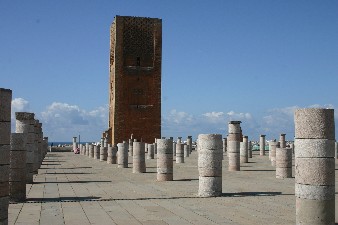 ,
his remains were sent to Paris, where he now rests in the ,
his remains were sent to Paris, where he now rests in the 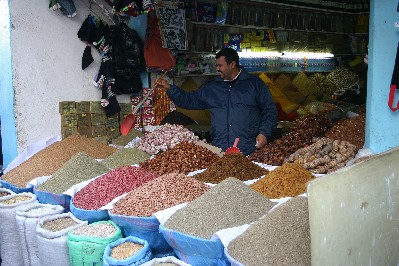 Dome des Invalides Dome des Invalides
Past the old town lies the Kasba
Ouïda. Through a magnificent gate you step into a labyrinth of small streets
and alleys, that lead us to the plateforme, a former bulwark overseeing
the river estuary. Salé the town on the north bank of the river, was until the
18th century a Pirate den. Now the plateforme is a favourite lookout point for
Moroccans and tourists alike. Through the maze of streets we reach the rue Bazo,
that leads to the Café Maure, where we enjoy mint tea and almond biscuits and a
superb view, while being waited upon by staff in moorish costumes. Guests are a
mix of Moroccans and tourists. Good fun. We walk back to the hotel.
At night we eat at the La Bamba restaurant.
Fine place with international and Moroccan meals. After dinner we stroll
allong the Boulevard Mohamed V in the Ville Nouvelle. We drink coffee and tea on
the popular outside tables of the hotel Balima.
We
are back at our hotel around 10.
Weather: sunny, max. 22ºC/72ºF.
Friday 6 April 2007
When we wake up at 7 it
is heavily overcast outside. It has rained earlier. We have breakfast and go on
our way to Fes. We take the toll road for Meknes. At Meknes we take the exit. We
want to visit the Roman ruins of  Volubilis.
Basically it is not difficult to drive to Volubilis from the exit of Meknes Est
(just straight on), but there are vitually almost no signs directing us that
way. It is about 30 km (19mi) from Meknes. It has started raining,
but when we arrive at Volubilis it stops. Volubilis
is an old Roman town, the ruins of which we are about to see. It was the most
remote Roman settlement and was founded at the beginning of the first century.
The Romans used the area for catching lions and bears, which were used for the
games at the Colloseum in Rome. The bears even became extinct because of it.
There are beautiful mosaics, but most of the houses lie in ruins. After the
Romans left in 285 AD the city remained in tact and many inhabitants (Jews,
Berbers and later Arabs) kept speaking Latin. In the 18th century the city was
torn down and its marble was used for building up Meknes. After the visit to the
site we drive to the village of Mulay Idriss. This a is a place of
pilgrimage for those who cannot afford a journey to Mecca. This is where the
mausoleum of Mulay Idrriss can be found. In 788 he founded the first Arab
dynasty in Morocco. He was the great grandson of the prophet Muhammad himself. A
young man is waiting for us at the parking lot and offers to guide us around. We
agree to hire him for 50dh. In 30 minutes he shows us the village, including a
great view of the mausoleum. After the tour he wants to lead us to a restaurant,
but do not feel like it. We carry on to Fes, where we arrive around 3pm.
We have some trouble finding our hotel. There hardly any road signs or signs
with street names and we have lost any idea of where we are on the map.
The we see a city map with an indication of where we are and that puts on the
right track again Volubilis.
Basically it is not difficult to drive to Volubilis from the exit of Meknes Est
(just straight on), but there are vitually almost no signs directing us that
way. It is about 30 km (19mi) from Meknes. It has started raining,
but when we arrive at Volubilis it stops. Volubilis
is an old Roman town, the ruins of which we are about to see. It was the most
remote Roman settlement and was founded at the beginning of the first century.
The Romans used the area for catching lions and bears, which were used for the
games at the Colloseum in Rome. The bears even became extinct because of it.
There are beautiful mosaics, but most of the houses lie in ruins. After the
Romans left in 285 AD the city remained in tact and many inhabitants (Jews,
Berbers and later Arabs) kept speaking Latin. In the 18th century the city was
torn down and its marble was used for building up Meknes. After the visit to the
site we drive to the village of Mulay Idriss. This a is a place of
pilgrimage for those who cannot afford a journey to Mecca. This is where the
mausoleum of Mulay Idrriss can be found. In 788 he founded the first Arab
dynasty in Morocco. He was the great grandson of the prophet Muhammad himself. A
young man is waiting for us at the parking lot and offers to guide us around. We
agree to hire him for 50dh. In 30 minutes he shows us the village, including a
great view of the mausoleum. After the tour he wants to lead us to a restaurant,
but do not feel like it. We carry on to Fes, where we arrive around 3pm.
We have some trouble finding our hotel. There hardly any road signs or signs
with street names and we have lost any idea of where we are on the map.
The we see a city map with an indication of where we are and that puts on the
right track again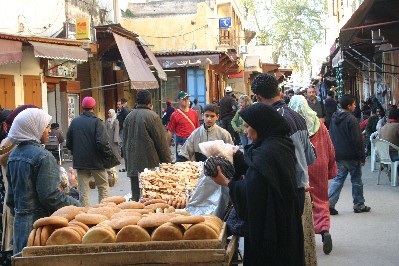 . We
cannot drive all the way up to the Riad Louna, but we have to walk the last bit.
Staff help us with our baggage and lead us to a safe and guarded parking lot
nearby. The hotel, Riad
Louna, is a Riad, a converted family house in the old town. It was built
around a patio with orange trees and a fountain and seems like an oasis of
silence amidst the hustle and bustle of the Medina. It does not look like much
from the outside, but on the inside is tastefully decorated. . We
cannot drive all the way up to the Riad Louna, but we have to walk the last bit.
Staff help us with our baggage and lead us to a safe and guarded parking lot
nearby. The hotel, Riad
Louna, is a Riad, a converted family house in the old town. It was built
around a patio with orange trees and a fountain and seems like an oasis of
silence amidst the hustle and bustle of the Medina. It does not look like much
from the outside, but on the inside is tastefully decorated.
We eat something nearby in the
old town. The Fes Medina consists of two parts: Fes el Bali (old Fes) in
the Sebou valley and Fes el Djedid (new Fes) from the 13th century on the edge
of the valley. After lunch we explore Fes el Djedid, the new Fes. Here is the
royal palace and the Mellah, the jewish quarter. The Jews have moved to Israel
since the independence and the Israeli-Egyptian war of 1956. Until then they
enjoyed the Sultan's protection, although their freedom of movement was very
limited. We walk to the Petit Mechouar, a little square, in front of the
rear entrance of the royal palace. It turns out that taking pictures of it is
not allowed. A policeman is convinced that I took one, but I can prove I did
not. We walk on through souks and have some tea on a side walk café. Later we
find the front of the palace which can be photographed.
Around 6pm we are back at the
Riad, where we have dinner at 7.30.
Weather: rain and cool,
12°C/54°F. Clear in the afternoon and slightly warmer, around 18°C/64°F
|
